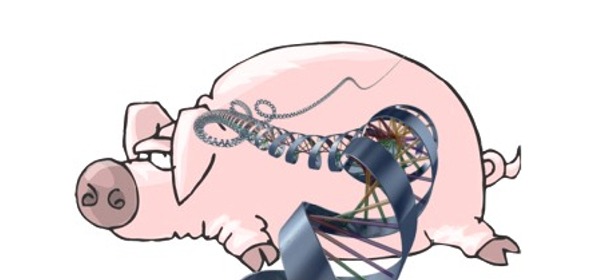Environment
Agribusiness Killed the Genetically Engineered Enviropig
In a look back at genetic modification of animals, we can be glad that the Enviropig didn’t make it to market. Although there was a public outcry, it had little to do with its failure. The problem was that Agribusiness had no interest. We dodged that bullet, but GM salmon will likely be a different story unless there’s a huge outcry.
 by Heidi Stevenson
by Heidi Stevenson
Current Status of Enviropig
In 2012 a great deal of rejoicing followed the announcement that the Enviropig program had been defunded, along with the claim that it was the public’s outcry that did it. While it’s true that the program, as it was then constituted, had lost its funding, it had nothing to do with the public’s outcry. The real reason was lack of commercial interest. The University of Guelph was unable to market it.
Agribusiness has no interest in improving either health or the environment, unless they can use it to sell a product for greater income. As long as the corporations that profit from horrendous pig CAFOs are not required to shoulder the environmental costs of their environmental damage, they will have no interest in genetically engineered feed animals designed to limit such damage. The University of Guelph made a serious tactical error, as stated by spokesperson Keith Robbins in April 2012, “Nobody from industry has stepped up at this stage.”
GM salmon, developed by AquaBounty, will likely have a different ending. In this case, the hopeful profiteer is the developer, and there’s no doubt that they have an interest in the fish. It’s also obvious, from this report of these GM salmon’s ability to breed with wild salmon and trout, creating superfish, that potential environmental devastation is of no concern to them.
Sources:
Original Article:
A genetically engineered pig has been approved by Health Canada and is under consideration by the US’s Food and Drug Administration (FDA). Dubbed Enviropig™ by its developer, the University of Guelph, it’s designed to reduce phosphorus output in feces.
These genetically modified (GM) pigs have been designed to serve the needs of the factory farming abomination. Because factory farmed pigs are fed an unnatural diet heavy in grains, their feces contain massive amounts of phosphorus, which promotes oxygen-depleting algae blooms, resulting in massive dead zones in rivers, lakes, and oceans, and creating cyanotoxins that can kill livestock, pets, and wildlife.
Agribusiness feeds grain to pigs and other animals grown for food because it’s cheap and results in fast growth. Pigs cannot readily digest grains, so they’re fed the enzyme phytase, which allows their digestive systems to break phosphorus down. However, the majority of it ends up in their waste. The GM pigs produce phytase in their salivary glands, so it travels through the entire digestive tract, breaking the phosphorus down so that more of it is absorbed into the pig’s metabolism, rather than being excreted.
Genes from a mouse and an E. coli bacterium are spliced into the pig’s genetic structure to create the Enviropig. It’s being sold with the claim that they will benefit the environment. This is the typical corporate approach to modern problems: Rather than try to resolve the root of the problem, a patch is used to hide it.
The problem is factory farming. The solution is an end to this inhumane, environmentally destructive, and health destroying practice, not technological bandaids that prolong and worsen the agony.
Health Risks
So, what happens to the phosphorus that no longer ends up in pig poop? It ends up in pig meat, of course—and if you eat that meat, it ends up in you. While phosphorous is a necessary nutrient, it is a poison when taken in excess. The classic condition caused by excess phosphorous is phossy jaw, the destruction of the jaw bone, which is a symptom of a deranged metabolism and systemic osteoporosis.
So, all that excess phosphorous ends up in people instead of pig poop.
Of course, excess phosphorus is only the predictable health risk. As always with genetic engineering, the full range of effects is unknown. GM foods have already been documented to cause harm in animals, including
Regulation of Enviropig
If any safety testing has been done on Enviropig meat, we are not informed. If it has been done, it’s been classified as confidential business information. The basis under which Health Canada approves GM products is not provided to the public. Therefore, we have absolutely no information on the effects of ingesting such meat—or even of the environmental effects. All we have is the hype.
The University of Guelph (UofG) holds patents for Enviropig in the US and China. China is a massive pork user and supplier, and UofG is actively pursuing business relationships there to gain regulatory approval.
Although the UofG applied for the FDA’s approval of Enviropig in 2007, a search of the FDA site turns up virtually no information. Is the FDA hiding Enviropig, hoping to slip it in behind genetically engineered salmon?
In the meantime, HealthCanada has recently approved Enviropig for limited production. It is not yet in production for the food supply, but it appears to be merely a matter of time before it is.
Mistakes Put Enviropig in Animal Feed
Animal feed has been contaminated by Enviropig. In 2002, eleven piglets were sent to a rendering plant and became part of 675 tons of poultry feed, which ended up being fed to egg-laying chickens, turkeys, and broiler chickens. According to The Globe and Mail, the UofG’s Vice President of Research effectively said, “Oops!”
Things you don’t expect to happen can happen.
This isn’t the only occasion that GM pigs have contaminated the food supply. In 2004, GM pigs designed for Big Pharma by TGN Biotech became chicken feed by carelessness.
Unintended Consequences
Though it will be sold as environmentally better by lessening the production of phosphorus in pig poop, which would presumably result in less phosphorus going into the environment, it’s unlikely to actually be good ecologically. Though the number is massively higher than it should be now, phosphorus is a limiting factor in factory farm density.
Regulations limit the number of pigs based partly on phosphorus output. John Phelps, a developer of Enviropig, was quote by Reuters in 1999 as saying that pig production could theoretically be increased by 50% if phosphorus waste were reduced by that much. He said that in North America, Europe, and Asia, the only thing holding back a farmer’s pig output is the amount of phosphorus that leaches into the water table.
Obviously, claims that the goal of Enviropigs will help the environment are nothing but hype, simply a sales technique. The anticipated result—not an unintended consequence, but an intended one—is to allow even more intensive pig farming.
That means, of course, that the rest of the nasty effects of Agribusiness farming will be intensified. There will be that much more antiobiotic and artificial hormone use, resulting in yet more running into the environment, with worsening of effects on wildlife, such as feminization of fish. It will also mean further reduction in human males’ reproductive ability and probably even earlier maturation of girls, whose onset of menstruation is already happening years earlier than it did just 20 years ago.
Air quality problems, which are devastating areas around pig factory farms, will become worse.
Of course, the most worrying unintended consequences are unknown. To understand the truth of this, one needs to look no further than the L-tryptophan disaster of 1989, which resulted in L-tryptophan being banned in the US. It’s now fairly well-known that the problem was a bad batch engineered Japanese batch that caused eosinophilia-myalgia syndrome (EMS), which killed 37 people. What isn’t commonly recognized, though, is that the batch had been produced by genetic engineering—that people died because of an unintended consequence of the GM process.
Sources:
- Enviropig
- Enviropig – Environmental Benefits
- Features of the Enviropig™ Biotechnology
- How The U.S. Food And Drug Administration Approved Genetically Engineered Foods Despite The Deaths One Had Caused And The Warnings Of Its Own Scientists About Their Unique Risks
- FDA Rules on Genetically Engineered Animals
- Is Canada’s genetically engineered “Enviropig” headed for your plate?
- Mouse and e coli genes injected into a Yorkshire pig embryo
Tagged agribusiness, enviropig, genetic engineering, genetic modification, gm salmon, university of guelph
Related Posts
3 Comments














Agribusiness Killed the Genetically Engineered Enviropig | Kinetic TruthJun 18, 2013 at 12:57 pm
[…] post Agribusiness Killed the Genetically Engineered Enviropig appeared first on […]
A Sterile & Dead World, Brought to You by AgribusinessJun 18, 2013 at 1:52 pm
[…] Agribusiness is now trying to sterilize the earth in its attempts to control what it has wrought. They pack animals into smaller and smaller spaces, often without room to turn around. They’ve engineered them to the point of destroying their nature. Picture the wild turkey, the wily forest fowl so impressive to Benjamin Franklin that he thought it should be the national bird, and compare that with the nearly mindless turkey of today, with breasts so big its legs cannot support it. Genetic engineering has produced fish that grow to huge size and can breed with native salmon and trout, resulting in superfish that can outcompete both their parents, not to mention the Enviropig. […]
10 Insane examples of Genetic Engineering | The FreeJun 24, 2013 at 7:29 pm
[…] Agribusiness Killed the Genetically Engineered Enviropig (gaia-health.com) […]